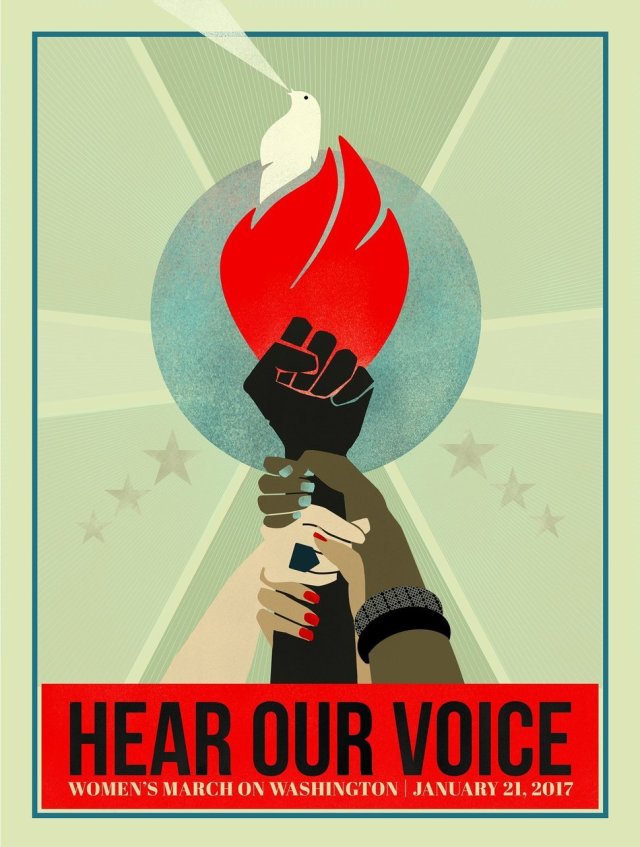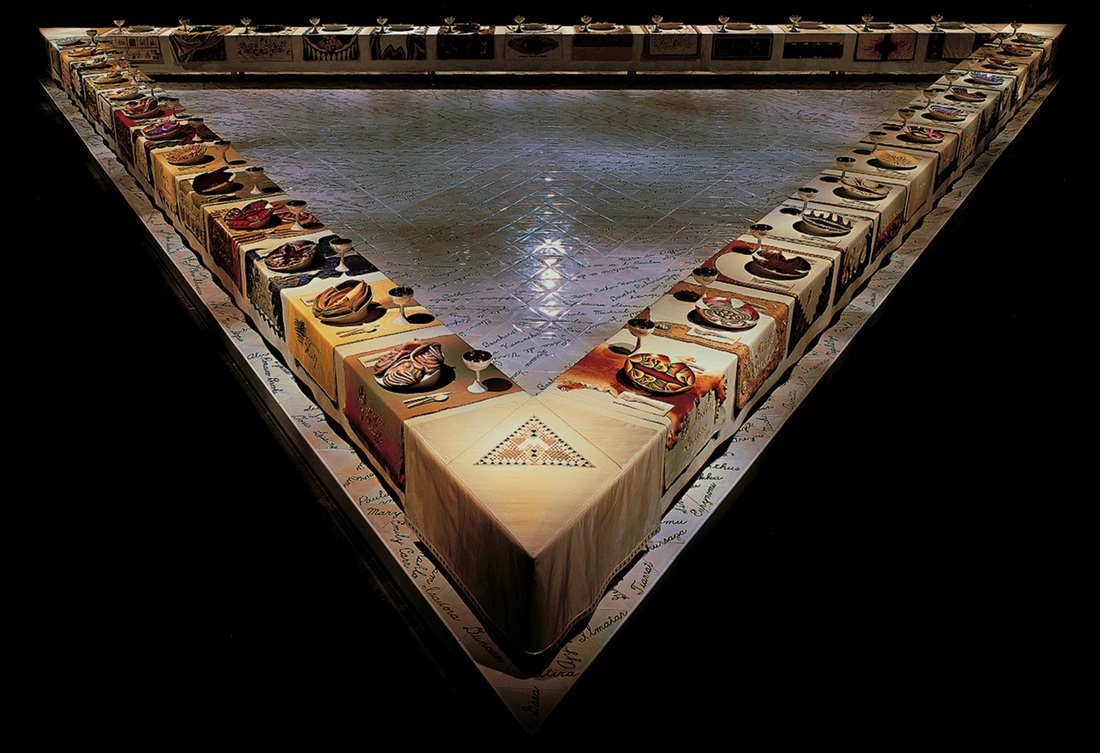S A M E D I F F E R E N C E
| Women's Right Movement, 1/21/2017 |
 |
| Liza Donovan, "Hear Our Voice," 2017 |
The Women’s March on
Washington - a march of thousands of women and men that supported the movement-
was an exceptional turnout. “Reflect and Resist” became the official symbol for
the movement. The turnout included mixture of people, including men, children,
trans-women, trans-men, celebrities. It began as with the march towards
Washington with signs that raised awareness to the political turmoil that the
US will suffer. The founder’s purpose was not just to “simply to protest
against the atrocities put forward by the current POTUS, but how the future of America
is comprised by the stance of women’s rights by the government. Protection of
our rights, our safety, our health, and our families – recognizing that our
vibrant and diverse communities are the strength of our country,” (Women’s
March Website). Some of the co-founders are Tamika D. Mallory, a woman that
worked with the Obama Administration to make a stance for women around the
world and Linda Sarsour, a “Brooklyn-born Palestinian-American-Muslim” woman
who has been fighting for social justice reform nationally. The Women’s March
has plenty of other founders that began this movement as a direct result to
President Trump’s comments on women. It began as a social movement that soon
became politically charged. It slowly began to grow into a global movement. The
global stance remains to empower women worldwide to stand up for rights. The
entire movement is based on working towards equality. This movement inspired
women worldwide with “sister marches,” visible on their website. They have the
100 days mission to work toward a cause to make the world a better place for
women and children.
The Women’s March on
Washington was underway when social media accounts such as Instagram and
Twitter exploded with the #Resist. #Resist
became a popular tag line for everyone commenting on the movement. There was twitter
uproar with one user commenting “MotherOfPartyGoblins: I’m marching with
#Women’s March today because all women should have the freedom to decide what
to do with their bodies and lives.” While another user Laurie Brookins,
“#WhyIMarch: Because I cannot stand the thought of four years of an
administration that will NEVER tell us the truth, #WomensMarch.” However, there
were women that have argued against the inclusion of all women in the march.
Furthermore, there was an absence of “intersectional feminism,” which is the
understanding of how women’s “overlapping identities — including race, class,
ethnicity, religion and sexual orientation — impact the way they experience
oppression and discrimination,” (Vox Website). While many women have seen the
positive aspect of the movement, there are women that have argued against the
controversial movement for its lack of inclusion. Ijeoma Oluo,a famous
Seattle-based publisher, who viewed the movement as empowering to white women,
leaving out some of the brutalities faced by colored women due to the
patriarchal society and role of women in African American men's’ lives. There
were many issues that were overlooked according to Oluo - who decided NOT to
participate in the movement. Similarly, another writer named Ree Walker argued
that white women were focused on feminist issues, while black women were
“centered on plight of the black males.” Walker argued that there was no
mention of issues surrounding “rape, sexual molestation, child molestation,
child support, etc.” (Walker, “Daily Kos” Website). Overall, there was a
mixture of emotions that sprung forward. While the movement gained traction,
there was a revolutionary art presentation by phenomenal artists.
 |
| Judy Chicago, The Dinner Party,1974-1979 |
“#Resist” has hundreds of art pieces that have
been created in support for women. Women such as Jessica Sabogal, created piece
such as “Women are Perfect.” Kate Deciccio created “Embracing Each Other” that
highlights the equality our body, our minds, our power. There are plenty of
other artists involved in the movement that highlighted the importance of
equality and women’s rights. These art pieces support the recent cause of such a political movement, however, there have been women in the past that have created masterpieces that support women's rights as well. Judy Chicago, for instance,
created a phenomenal masterpiece called “The Dinner Party” that displayed the
most influential women artists that had to fight their own political causes to
be considered equals. In the art world, the designs created by women were sacrificed to give recognition to the male artists. "The Dinner Party" highlights women such as Artemesia Gentileschi - who was a strong, courageous woman. Her work is an intricate design that highlights women and
their art pieces. The masterpiece is designed as a triangle in which hundreds
of women are honored. These women fought the political movement and equality for years. Similarly,
the fight has been visible in performance pieces in the past. In 1964, a woman
named Yoko Ono did a performance piece named “Cut Piece.” The purpose of “Cut
Piece” was to allow the audience to interact with her while performing. They
were allowed to cut pieces of her clothing off her body. However, she noticed that people were
cutting pieces off her bra, and eventually made her almost naked. The moral of
the story became that women are immediately turned into objects if given the
chance. The political fight continues with artists such as Barbara Kruger that
push forward a political agenda. Her artwork focuses on consumerism and how it values women. Although most of the advertisements for commerical products are targeted to women, they are not considered equals. Kruger expresses the disconcert inequality through her artpieces.She creates art with pieces cut from
different magazines that present a political agenda. For instance, her “The War
for Me to Become You,” or “I Shop, Therefore I am.” The political agendas are further demonstrated by a group of feminist activists called "The Guerrilla Girls." The Guerilla Girls are an anonymous group of women that are focused on political movements throughout the years. The approach used by the Guerrilla Girls is a gathering of over 55 women that fight against anti-feminist ideologies through anonymous, humorous and outrageous means. The election of Donald Trump has also led to a mockery of his election. The projects involved creating a calendar that mocks all the outrageous things that the current POTUS has promised within the 100 days of his election. These women have used their
artistic talents to push forth for a stronger, more prominent agenda: equality.
These art pieces and performances not only speak to the women, but to the society
that we live in. The recent presidential election represents how our society is
still incompetent in picking leaders that will further the cause of equality.
There’s a direct correlation to the women that have made these art pieces to
women that have stood long and tall against the tyrannies demonstrated by the
current president.
 |
| The Guerilla Girls, 2016 |
 |
| Barbara Kruger, Untitled, 1987 |
Is there a difference
between men and women? YES! Men have always been privileged in political terms,
in art terms, in wage, property ownership, and almost every other factor of
life that drives this capitalistic society. No matter the race, the culture,
men have overstepped and consistently been given the stance as a superior
gender. “Same Difference” speaks on a sentimental level. Yes, there’s a
difference between the strengths of men and women, but we are all the same. We
can accomplish everything in equivalence to men. It’s the 21st century, and
yet, there needs to be a movement to demonstrate the strength, resilience and
power of women. In almost every occupation, there’s been a competition for
women to prove themselves. Why is that? We are all the same; we are all capable
of greatness. Yet our gender, a small difference, causes a rift between what we
as a society can accomplish. Art is a form of expression - a style of greatness
that is only visible if the rift between men and women can be diminished. Women
in Art made me realize that protest doesn’t need to be through political
agendas only; they can be through our freedom of expression.
Works
Cited
Desmond-Harris, Jenee. "To Understand the
Women's March on Washington, You Need to Understand Intersectional
Feminism." Vox. Vox, 17 Jan. 2017. Web.
"The Black Woman's "Women's
March" Problem: It Ain't Just White Folks." Daily Kos. N.p.,
n.d. Web. 23 Apr. 2017.
Sanchez, Allison. "Take A Look At The Art
Powering The Women's March On Washington." UPROXX. UPROXX, 19 Jan.
2017. Web. 23 Apr. 2017.
"Women's March on Washington." Women's
March on Washington. Web.
"Yoko Ono’s Cut Piece explained | Art |
Agenda | Phaidon." Home | Phaidon. Phaidon, Web.
"Barbara Kruger - 37 Artworks, Bio &
Shows on Artsy." Artsy - Discover, Research, and Collect the World's
Best Art Online.
"Judy Chicago Biography, Art, and Analysis
of Works | The Art Story." The Art Story: Modern Art Movements, Artists,
Ideas and Topics. Web.
OUR STORY — Guerrilla Girls. Guerilla Girls, n.d. Web. 24 Apr. 2017.

No comments:
Post a Comment